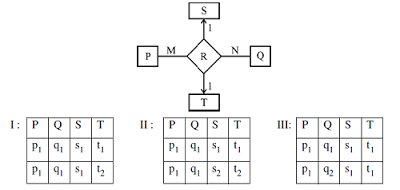Welcome to the DBMS MCQs Page
Dive deep into the fascinating world of DBMS with our comprehensive set of Multiple-Choice Questions (MCQs). This page is dedicated to exploring the fundamental concepts and intricacies of DBMS, a crucial aspect of UGC CBSE NET Exam. In this section, you will encounter a diverse range of MCQs that cover various aspects of DBMS, from the basic principles to advanced topics. Each question is thoughtfully crafted to challenge your knowledge and deepen your understanding of this critical subcategory within UGC CBSE NET Exam.
Check out the MCQs below to embark on an enriching journey through DBMS. Test your knowledge, expand your horizons, and solidify your grasp on this vital area of UGC CBSE NET Exam.
Note: Each MCQ comes with multiple answer choices. Select the most appropriate option and test your understanding of DBMS. You can click on an option to test your knowledge before viewing the solution for a MCQ. Happy learning!
DBMS MCQs | Page 7 of 23
Explore more Topics under UGC CBSE NET Exam
Works (emp_name, company_name, salary)
Here, emp_name is primary key.
Consider the following SQL query:
Select emp_name
From Works T
where salary>(select avg (salary)
from Works S
where T.company_name=
S. Company_name)
The above query is for following:
(a) NULL values can be used to opt a tuple out of enforcement of a foreign key.
(b) Suppose that table T has only one candidate key. If Q is in 3NF, then it is also in BCNF.
(c) The difference between the project operator (P) in relational algebra and the SELECT keyword in SQL is that if the resulting table/set has more than one occurrences of the same tuple, then P will return only one of them, while SQL SELECT will return all.
One can determine that:
If different symbols stand for different values (e.g., t1 is definitely not equal to t2), then which of the above could not be the relationship set for the E-R diagram ?

I. An OODBMS avoids the “impedance mismatch” problem.
II. An OODBMS avoids the “phantom” problem.
III. An OODBMS provides higher performance concurrency control than most relational databases.
IV. An OODBMS provides faster access to individual data objects once they have been read from disk.
The number of tuples in the resulting table of RA1, RA2 and RA3 are given by:

I. The decomposition of R into R1(C, A) and R2(A, B) is lossless.
II. The decomposition of R into R1(A, B) and R2(B, C) is lossy.
Suggested Topics
Are you eager to expand your knowledge beyond DBMS? We've curated a selection of related categories that you might find intriguing.
Click on the categories below to discover a wealth of MCQs and enrich your understanding of Computer Science. Happy exploring!








